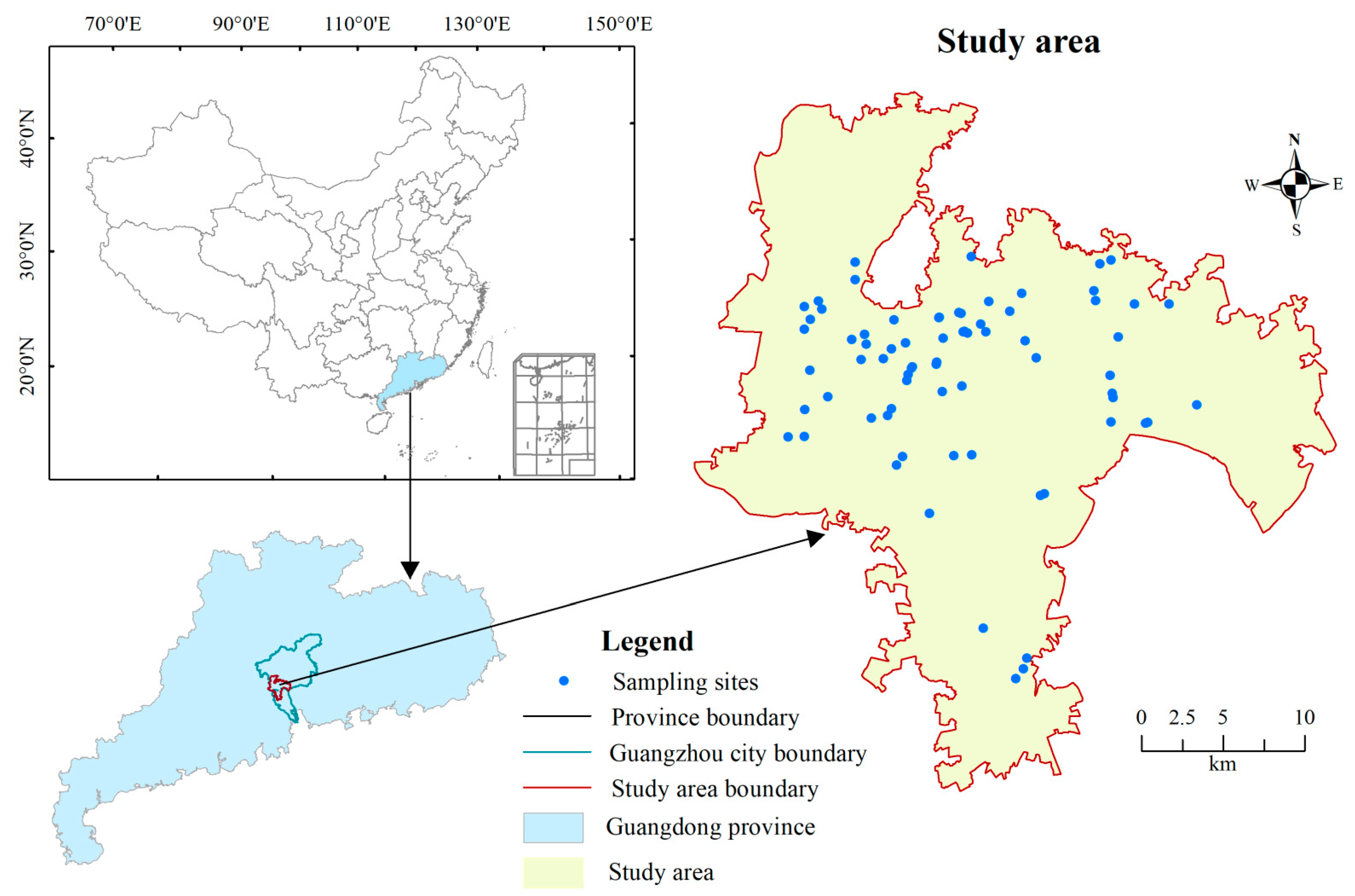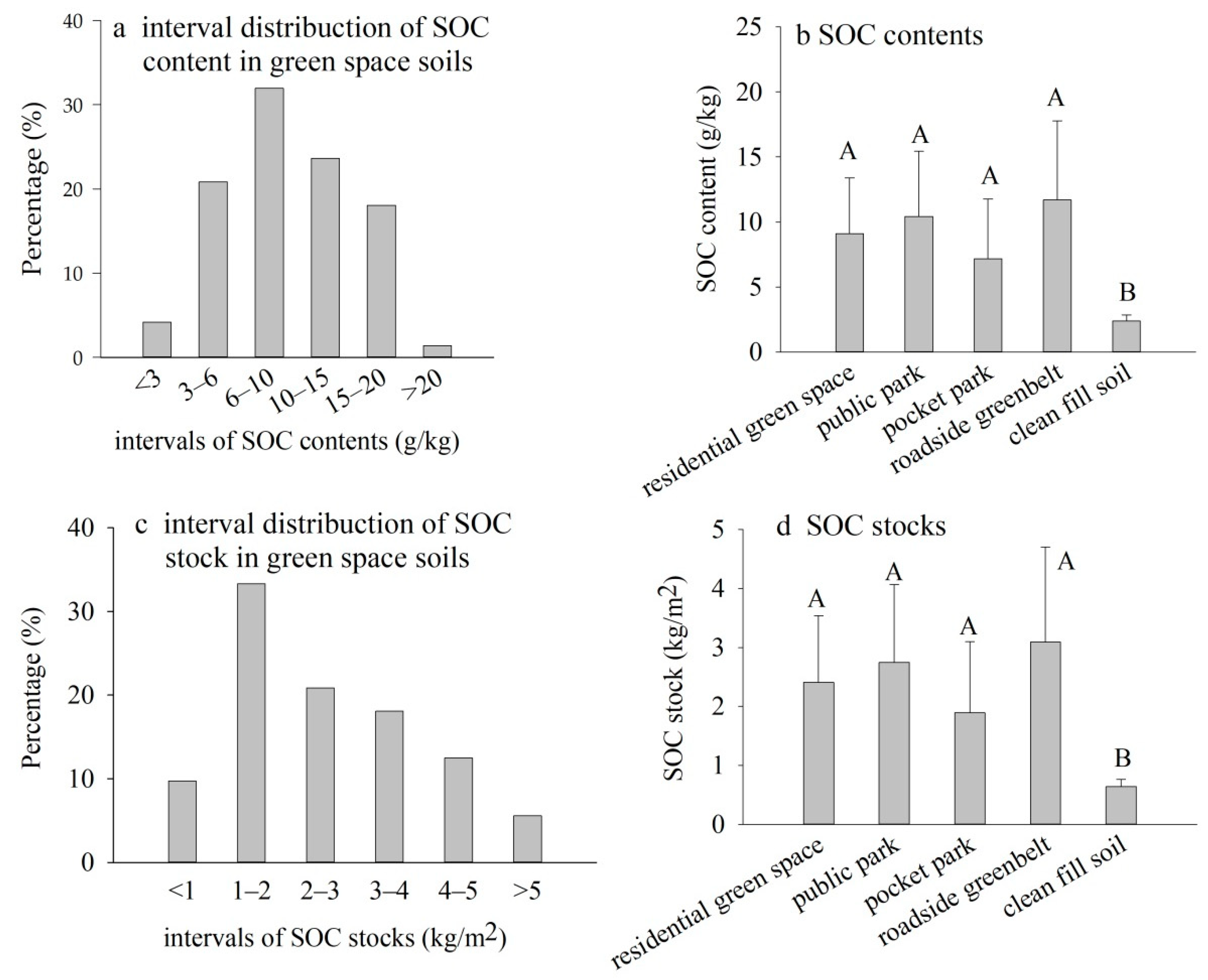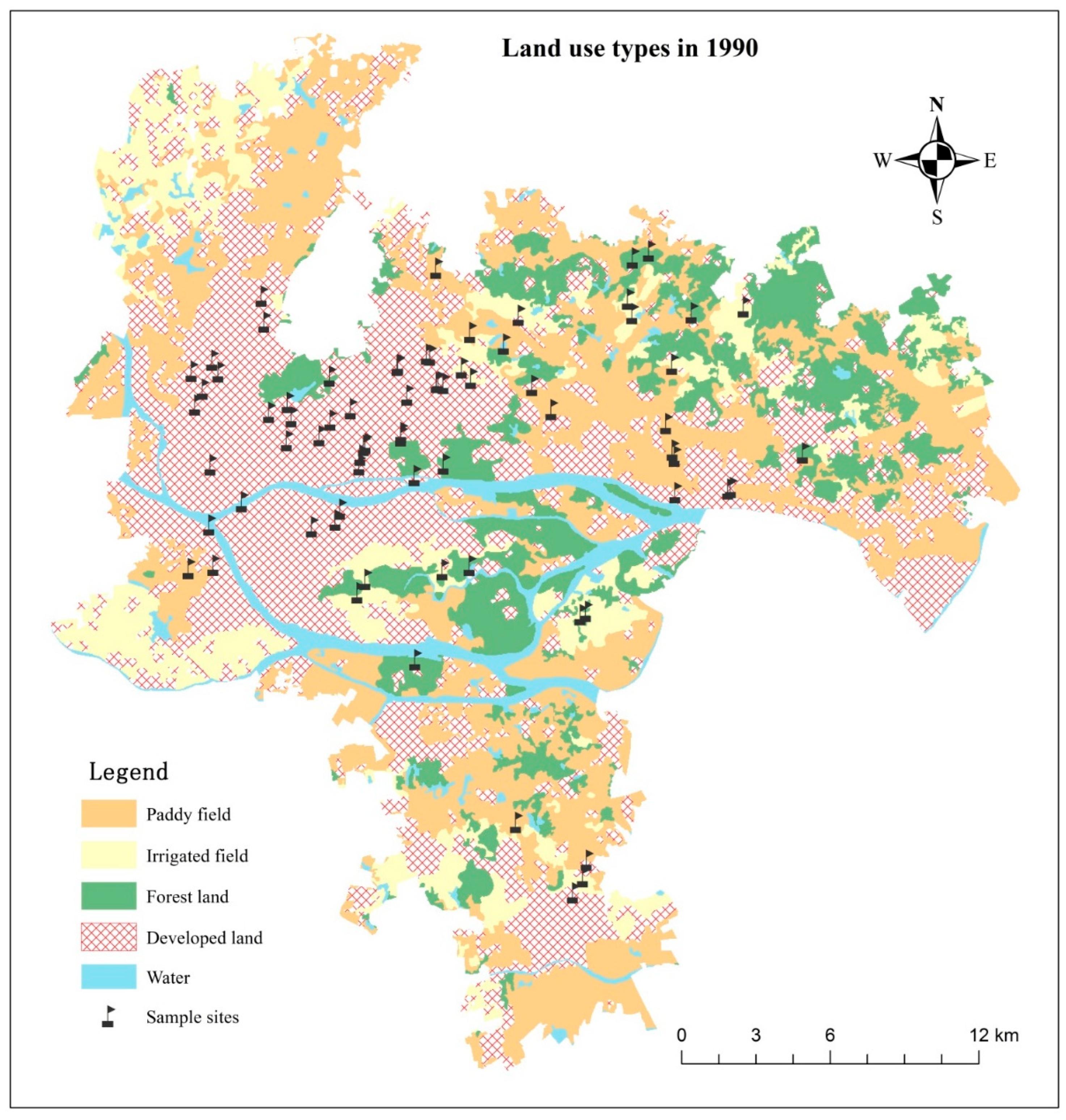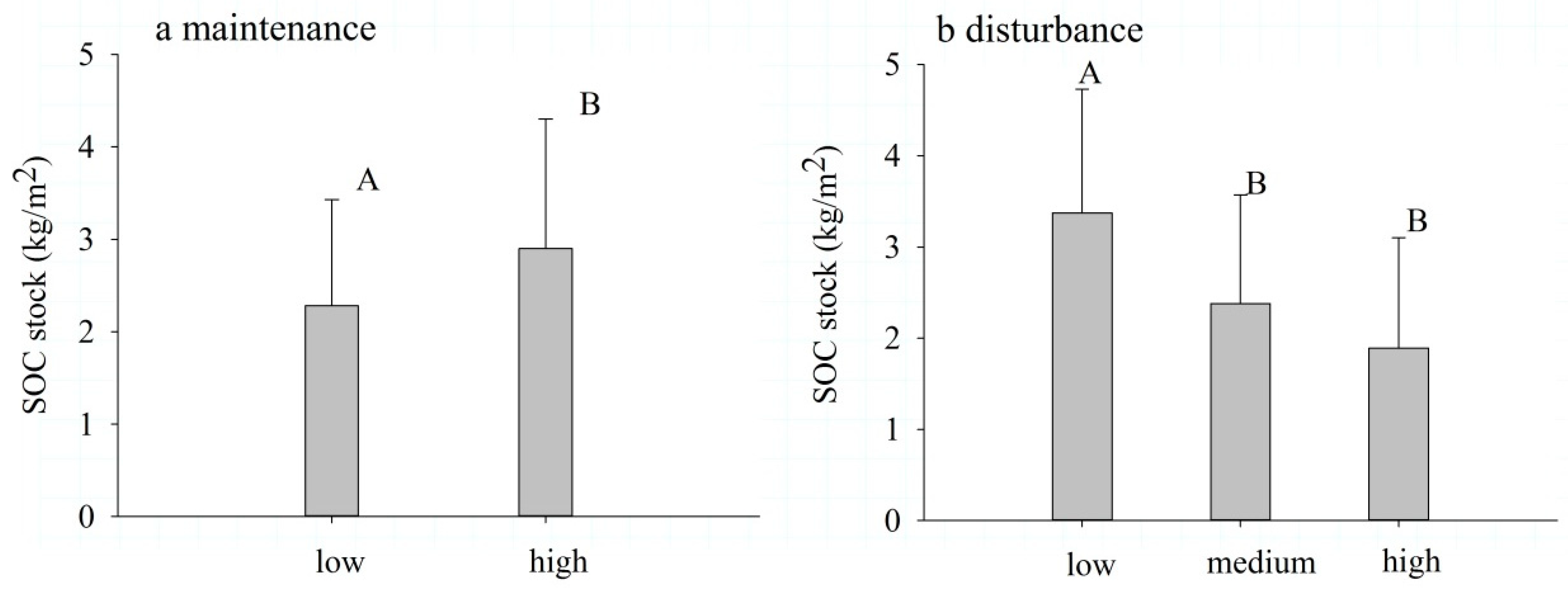Soil Organic Carbon Storage in Urban Green Space and Its Influencing Factors: A Case Study of the 0–20 cm Soil Layer in Guangzhou City
Abstract
:1. Introduction
2. Materials and Methods
2.1. Study Site
2.2. Experimental Design and Soil Sampling
2.3. Data Sources of Soil Type, Soil Texture and Land Use History
2.4. Statistical Analysis
3. Results
3.1. SOC Content and SOC Stocks
3.2. Soil Type, Soil Texture and Land Use History
3.3. The Differences in SOC Stock among Maintenance and Disturbance Types
3.4. Factors Affecting SOC Stock
4. Discussion
4.1. SOC Content and SOC Stock
4.2. Plot Age and SOC Storage
4.3. Maintenance and SOC Storage
4.4. Anthropogenic Disturbance and SOC Storage
4.5. The Influence of Soil Texture, Soil Type and Land Use History
4.6. Limitations and Future Implications
5. Conclusions
Supplementary Materials
Author Contributions
Funding
Institutional Review Board Statement
Informed Consent Statement
Data Availability Statement
Acknowledgments
Conflicts of Interest
References
- Schneider, A.; Friedl, M.A.; Potere, D. A new map of global urban extent from MODIS satellite data. Environ. Res. Lett. 2009, 4, 44003–44011. [Google Scholar] [CrossRef]
- Gurney, K.R.; Romero-Lankao, P.; Seto, K.C.; Hutyra, L.R.; Duren, R.; Kennedy, C.; Grimm, N.B.; Ehleringer, J.R.; Marcotullio, P.; Hughes, S.; et al. Climate change: Track urban emissions on a human scale. Nature 2015, 525, 179–181. [Google Scholar] [CrossRef] [PubMed]
- Seto, K.C.; Güneralp, B.; Hutyra, L.R. Global forecasts of urban expansion to 2030 and direct impacts on biodiversity and carbon pools. Proc. Natl. Acad. Sci. USA 2012, 109, 16083–16088. [Google Scholar] [CrossRef]
- United Nations. World Urbanization Prospects: The 2018 Revision; United Nations: New York, NY, USA, 2019. [Google Scholar]
- Milner, J.; Davies, M.; Wilkinson, P. Urban energy, carbon management (low carbon cities) and co-benefits for human health. Curr. Opin. Environ. Sustain. 2012, 4, 398–404. [Google Scholar] [CrossRef]
- Zhang, L.; Yang, L.; Zohner, C.M.; Crowther, T.W.; Li, M.; Shen, F.; Guo, M.; Qin, J.; Yao, L.; Zhou, C. Direct and indirect impacts of urbanization on vegetation growth across the world’s cities. Sci. Adv. 2022, 8, eabo0095. [Google Scholar] [CrossRef]
- Nowak, D.J.; Greenfield, E.J.; Hoehn, R.E.; Lapoint, E. Carbon storage and sequestration by trees in urban and community areas of the United States. Environ. Pollut. 2013, 178, 229–236. [Google Scholar] [CrossRef]
- Sun, Y.; Xie, S.; Zhao, S. Valuing urban green spaces in mitigating climate change: A city-wide estimate of aboveground carbon stored in urban green spaces of China’s Capital. Glob. Chang. Biol. 2019, 25, 1717–1732. [Google Scholar] [CrossRef]
- Edmondson, J.L.; Davies, Z.G.; McHugh, N.; Gaston, K.J.; Leake, J. Organic carbon hidden in urban ecosystems. Sci. Rep. 2012, 2, 963. [Google Scholar] [CrossRef]
- Golubiewski, N.E. Urbanization increases grassland carbon pools: Effects of landscaping in Colorado’s Front Range. Ecol. Appl. 2006, 16, 555–571. [Google Scholar] [CrossRef]
- Pouyat, R.V.; Yesilonis, I.; Golubiewski, N.E. A comparison of soil organic carbon stocks between residential turf grass and native soil. Urban Ecosyst. 2009, 12, 45–62. [Google Scholar] [CrossRef]
- Raciti, S.M.; Hutyra, L.R.; Finzi, A.C. Depleted soil carbon and nitrogen pools beneath impervious surfaces. Environ. Pollut. 2012, 164, 248–251. [Google Scholar] [CrossRef] [PubMed]
- Vasenev, V.; Kuzyakov, Y. Urban soils as hot spots of anthropogenic carbon accumulation: Review of stocks, mechanisms and driving factors. Land Degrad. Dev. 2018, 29, 1607–1622. [Google Scholar] [CrossRef]
- Wei, Z.; Wu, S.; Zhou, S.; Li, J.; Zhao, Q. Soil organic carbon transformation and related properties in urban soil under impervious surfaces. Pedosphere 2014, 24, 56–64. [Google Scholar] [CrossRef]
- Lu, C.; Kotze, D.J.; Setälä, H.M. Soil sealing causes substantial losses in C and N storage in urban soils under cool climate. Sci. Total Environ. 2020, 725, 138369. [Google Scholar] [CrossRef]
- Churkina, G. The Role of Urbanization in the Global Carbon Cycle. Front. Ecol. Evol. 2016, 3, 144. [Google Scholar] [CrossRef]
- Qian, Y.; Follett, R.F. Assessing Soil carbon sequestration in turfgrass systems using long-term soil testing data. Agron. J. 2002, 94, 930–935. [Google Scholar] [CrossRef]
- Raciti, S.M.; Groffman, P.; Jenkins, J.C.; Pouyat, R.V.; Fahey, T.J.; Pickett, S.T.A.; Cadenasso, M.L. Accumulation of carbon and nitrogen in residential soils with different land-use histories. Ecosystems 2011, 14, 287–297. [Google Scholar] [CrossRef]
- Smith, R.M.; Williamson, J.C.; Pataki, D.E.; Ehleringer, J.; Dennison, P. Soil carbon and nitrogen accumulation in residential lawns of the Salt Lake Valley, Utah. Oecologia 2018, 187, 1107–1118. [Google Scholar] [CrossRef]
- Lu, C.; Kotze, D.J.; Setälä, H.M. Evergreen trees stimulate carbon accumulation in urban soils via high root production and slow litter decomposition. Sci. Total Environ. 2021, 774, 145129. [Google Scholar] [CrossRef]
- Contosta, A.R.; Lerman, S.B.; Xiao, J.; Varner, R.K. Biogeochemical and socioeconomic drivers of above- and below-ground carbon stocks in urban residential yards of a small city. Landsc. Urban Plan. 2020, 196, 103724. [Google Scholar] [CrossRef]
- Canedoli, C.; Ferrè, C.; Abu El Khair, D.; Padoa-Schioppa, E.; Comolli, R. Soil organic carbon stock in different urban land uses: High stock evidence in urban parks. Urban Ecosyst. 2019, 23, 159–171. [Google Scholar] [CrossRef]
- Allory, V.; Séré, G.; Ouvrard, S. A meta-analysis of carbon content and stocks in Technosols and identification of the main governing factors. Eur. J. Soil Sci. 2021, 73, e13141. [Google Scholar] [CrossRef]
- Anne, B.; Geoffroy, S.; Cherel, J.; Warot, G.; Marie, S.; Noël, C.J.; Louis, M.J.; Christophe, S. Towards an operational methodology to optimize ecosystem services provided by urban soils. Landsc. Urban Plan. 2018, 176, 1–9. [Google Scholar] [CrossRef]
- Morel, J.L.; Chenu, C.; Lorenz, K. Ecosystem services provided by soils of urban, industrial, traffic, mining, and military areas (SUITMAs). J. Soils Sediments 2014, 15, 1659–1666. [Google Scholar] [CrossRef]
- Riddle, R.L.; Siebecker, M.G.; Weindorf, D.C.; Shaw, R.K.; Scharenbroch, B.C. Soils in urban and built environments: Pedogenic processes, characteristics, mapping, and classification. Adv. Agron. 2022, 173, 227–255. [Google Scholar] [CrossRef]
- Edmondson, J.L.; Davies, Z.G.; McCormack, S.A.; Gaston, K.J.; Leake, J. Land-cover effects on soil organic carbon stocks in a European city. Sci. Total Environ. 2014, 472, 444–453. [Google Scholar] [CrossRef] [PubMed]
- Ziter, C.; Turner, M.G. Current and historical land use influence soil-based ecosystem services in an urban landscape. Ecol. Appl. 2018, 28, 643–654. [Google Scholar] [CrossRef] [PubMed]
- Schmitt-Harsh, M.; Mincey, S.K.; Patterson, M.; Fischer, B.C.; Evans, T.P. Private residential urban forest structure and carbon storage in a moderate-sized urban area in the Midwest, United States. Urban For. Urban Green. 2013, 12, 454–463. [Google Scholar] [CrossRef]
- Sun, Y.; Ma, J.; Li, C. Content and densities of soil organic carbon in urban soil in different function districts of Kaifeng. J. Geogr. Sci. 2010, 20, 148–156. [Google Scholar] [CrossRef]
- Liu, Y.; Wang, C.; Yue, W.; Hu, Y. Storage and density of soil organic carbon in urban topsoil of hilly cities: A case study of Chongqing Municipality of China. Chin. Geogr. Sci. 2013, 23, 26–34. [Google Scholar] [CrossRef]
- Cambou, A.; Saby, N.P.; Hunault, G.; Nold, F.; Cannavo, P.; Schwartz, C.; Vidal-Beaudet, L. Impact of city historical management on soil organic carbon stocks in Paris (France). J. Soils Sediments 2021, 21, 1038–1052. [Google Scholar] [CrossRef]
- Huyler, A.; Chappelka, A.H.; Prior, S.A.; Somers, G.L. Influence of aboveground tree biomass, home age, and yard maintenance on soil carbon levels in residential yards. Urban Ecosyst. 2014, 17, 787–805. [Google Scholar] [CrossRef]
- Huyler, A.; Chappelka, A.H.; Prior, S.A.; Somers, G.L. Drivers of soil carbon in residential ‘pure lawns’ in Auburn, Alabama. Urban Ecosyst. 2013, 17, 205–219. [Google Scholar] [CrossRef]
- Campbell, C.D.; Seiler, J.R.; Wiseman, P.E.; Strahm, B.D.; Munsell, J.F. Soil carbon dynamics in residential lawns converted from Appalachian mixed oak stands. Forests 2014, 5, 425–438. [Google Scholar] [CrossRef]
- Kaye, J.P.; Groffman, P.M.; Grimm, N.; Baker, L.A.; Pouyat, R.V. A distinct urban biogeochemistry? Trends Ecol. Evol. 2006, 21, 192–199. [Google Scholar] [CrossRef] [PubMed]
- Li, H.; Chen, W.; He, W. Planning of green space ecological network in urban areas: An example of Nanchang, China. Int. J. Environ. Res. Public Health 2015, 12, 12889–12904. [Google Scholar] [CrossRef]
- Statistics Bureau of Guangzhou City. Guangzhou Statistical Yearbook of 2020 and 2000; China Statistics Press: Beijing, China, 2021. Available online: http://112.94.72.17/portal/queryInfo/statisticsYearbook/index (accessed on 7 February 2021).
- Soil Census Office of Guangdong Province. Soils of Guangdong Province, 1st ed.; Science Press: Beijing, China, 1996; p. 103.
- Wiesmeier, M.; Urbanski, L.; Hobley, E.; Lang, B.; von Lützow, M.; Marin-Spiotta, E.; van Wesemael, B.; Rabot, E.; Ließ, M.; Garcia-Franco, N.; et al. Soil organic carbon storage as a key function of soils—A review of drivers and indicators at various scales. Geoderma 2018, 333, 149–162. [Google Scholar] [CrossRef]
- Nelson, D.W.; Sommers, L.E. Total carbon, organic carbon, and organic matter. In Methods of Soil Analysis; Sparks, D., Page, A., Helmke, P., Loeppert, R., Soltanpour, P.N., Tabatabai, M.A., Johnston, C.T., Sumner, M.E., Eds.; Wiley: Hoboken, NJ, USA, 1996. [Google Scholar] [CrossRef]
- Guan, D.; He, K.; Chen, Y. The soil characteristics of Guangzhou urban vegetation and its effects on tree growth. Chin. J. Res. Environ. Sci. 1998, 11, 51–54. [Google Scholar] [CrossRef]
- Zhuo, W.; Tang, J.; Guan, D. A study on the soil properties of urban green space in Guangzhou and the impact of human activities on them. Chin. J. Acta Sci. Nat. Univ. Sunyatseni 2007, 46, 32–35. [Google Scholar] [CrossRef]
- Zhu, C.; Xiong, Y.; He, M.; Feng, Y. Soil physico-chemical properties and their correlations in a greenbelt in Guangzhou. Chin. J. Ecol. Environ. Sci. 2010, 19, 1868–1871. [Google Scholar] [CrossRef]
- Jim, C.Y. Soil Characteristics and management in an urban park in Hong Kong. Environ. Manag. 1998, 22, 683–695. [Google Scholar] [CrossRef] [PubMed]
- Zhang, Y. The Carbon Footprint Accounting and Assessment Study of Guangzhou Typical Urban Green Space; Huazhong Agricultural University: Wuhan, China, 2013; p. 6. [Google Scholar]
- Soil Census Office of Guangdong Province. Soil Chorography of Guangdong Province, 1st ed.; Science Press: Beijing, China, 1996; pp. 92, 120, 125, 252, 280, 288, 390, 408, 410.
- Xu, X.; Liu, J.; Zhang, S.; Li, R.; Yan, C.; Wu, S. China’s Multi-Period Land Use/Cover Remote Sensing Monitoring Dataset (CNLUCC); Data Registration and Publishing System of the Resource and Environmental Science Data Center of the Chinese Academy of Sciences: Beijing, China, 2018. [Google Scholar] [CrossRef]
- Zhang, X.; Guan, D.; Li, H.; Huang, K.; Xu, Z. Allocation characteristic of organic carbon pool in typical forest soils in Guangzhou. Chin. J. Acta Sci. Nat. Univ. Sunyatseni 2009, 48, 137–142. [Google Scholar] [CrossRef]
- Lu, Y.; Gan, H.; Shi, Z.; Liu, Z. Soil fertility quality assessment and managing measures for urban green space in Shenzhen city. Chin. J. Soil Water Conserv. 2005, 19, 153–156. [Google Scholar] [CrossRef]
- Lu, Y.; Feng, H.; Gan, H. Soil fertility characteristics and enzyme activity for urban parks in Guangzhou City. Chin. J. Soil Water Conserv. 2007, 21, 160–163. [Google Scholar] [CrossRef]
- He, Z.; Huang, L.; Cheng, H.; Wang, J. Soil fertility evaluation and related soil improvement and utilization of Nansha seaside park in Guangzhou. Chin. J. Guangdong For. Sci. Technol. 2001, 27, 51–54. [Google Scholar] [CrossRef]
- Wu, Z.; Huang, Y.; Jiang, C. Soil and vegetation carbon storage and its spatial pattern analysis of Guangzhou City, China. Chin. J. Guangzhou Univ. Nat. Sci. Ed. 2014, 13, 73–79. [Google Scholar]
- Fang, Y.; Mo, J.; Sandra, B.; Zhou, G.; Zhang, Q.; Li, D. Storage and distribution of soil organic carbon in Dinghushan Biosphere Reserve. Chin. J. Acta Ecol. Sin. 2004, 24, 135–142. [Google Scholar] [CrossRef]
- Chien, S.-C.; Krumins, J.A. Natural versus urban global soil organic carbon stocks: A meta-analysis. Sci. Total Environ. 2021, 807, 150999. [Google Scholar] [CrossRef]
- Cambou, A.; Shaw, R.K.; Huot, H.; Vidal-Beaudet, L.; Hunault, G.; Cannavo, P.; Nold, F.; Schwartz, C. Estimation of soil organic carbon stocks of two cities, New York City and Paris. Sci. Total Environ. 2018, 644, 452–464. [Google Scholar] [CrossRef] [Green Version]
- Huh, K.Y.; Deurer, M.; Sivakumaran, S.; McAuliffe, K.; Bolan, N.S. Carbon sequestration in urban landscapes: The example of a turfgrass system in New Zealand. Soil Res. 2008, 46, 610–616. [Google Scholar] [CrossRef]
- Stewart, C.E.; Paustian, K.; Conant, R.; Plante, A.; Six, J. Soil carbon saturation: Concept, evidence and evaluation. Biodegradation 2007, 86, 19–311. [Google Scholar] [CrossRef]
- Pouyat, R.V.; Yesilonis, I.D.; Nowak, D.J. Carbon storage by urban soils in the United States. J. Environ. Qual. 2006, 35, 1566–1575. [Google Scholar] [CrossRef] [PubMed]
- Stewart, C.E.; Paustian, K.; Conant, R.T.; Plante, A.F.; Six, J. Soil carbon saturation: Evaluation and corroboration by long-term incubations. Soil Biol. Biochem. 2008, 40, 1741–1750. [Google Scholar] [CrossRef]
- Hardin, G. The Tragedy of the Commons. Science 1968, 162, 1243–1248. [Google Scholar] [CrossRef] [PubMed]
- Alchian, A.A.; Demsetz, H. Production, information costs, and economic organization. Am. Econ. Rev. 1972, 62, 777–795. [Google Scholar] [CrossRef]
- Chen, S.; Wang, Y.; Ni, Z.; Zhang, X.; Xia, B. Benefits of the ecosystem services provided by urban green infrastructures: Differences between perception and measurements. Urban For. Urban Green. 2020, 54, 126774. [Google Scholar] [CrossRef]
- Du, J.; Yu, M.; Yan, J. The Impact of impervious surface expansion on soil organic carbon: A case study of 0–300 cm soil layer in Guangzhou city. Sustainability 2021, 13, 7901. [Google Scholar] [CrossRef]
- Luo, S.; Mao, Q.; Ma, K.; Wu, J. A review of carbon cycling and sequestration in urban soils. Chin. J. Acta Ecol. Sin. 2012, 32, 7177–7189. [Google Scholar] [CrossRef]
- Nawaz, M.F.; Bourrié, G.; Trolard, F. Soil compaction impact and modelling. A review. Agron. Sustain. Dev. 2012, 33, 291–309. [Google Scholar] [CrossRef] [Green Version]
- Lou, D.; Chen, Y.; Liu, K.; Chen, Y.; Ma, L.; Yu, C.; Guan, D. Effects of patch size variation on biomass in Fengshui forest in east Guangzhou. Acta Sci. Nat. Univ. Sunyatseni 2019, 58, 12–21. [Google Scholar] [CrossRef]
- Six, J.; Conant, R.T.; Paul, E.A.; Paustian, K. Stabilization mechanisms of soil organic matter: Implications for C-saturation of soils. Plant Soil 2002, 241, 155–176. [Google Scholar] [CrossRef]
- McLauchlan, K.K. Effects of soil texture on soil carbon and nitrogen dynamics after cessation of agriculture. Geoderma 2006, 136, 289–299. [Google Scholar] [CrossRef]
- Trammell, T.L.E.; Pouyat, R.V.; Carreiro, M.M.; Yesilonis, I. Drivers of soil and tree carbon dynamics in urban residential lawns: A modeling approach. Ecol. Appl. 2017, 27, 991–1000. [Google Scholar] [CrossRef] [PubMed]
- Mayes, M.; Marin-Spiotta, E.; Szymanski, L.; Erdoğan, M.A.; Ozdoğan, M.; Clayton, M. Soil type mediates effects of land use on soil carbon and nitrogen in the Konya Basin, Turkey. Geoderma 2014, 232–234, 517–527. [Google Scholar] [CrossRef]
- Stockmann, U.; Adams, M.A.; Crawford, J.W.; Field, D.J.; Henakaarchchi, N.; Jenkins, M.; Minasny, B.; McBratney, A.B.; de Courcelles, V.d.R.; Singh, K.; et al. The knowns, known unknowns and unknowns of sequestration of soil organic carbon. Agric. Ecosyst. Environ. 2013, 164, 80–99. [Google Scholar] [CrossRef]
- Delbecque, N.; Dondeyne, S.; Gelaude, F.; Mouazen, A.M.; Vermeir, P.; Verdoodt, A. Urban soil properties distinguished by parent material, land use, time since urbanization, and pre-urban geomorphology. Geoderma 2022, 413, 115719. [Google Scholar] [CrossRef]
- Jim, C.Y. Physical and chemical properties of a Hong Kong roadside soil in relation to urban tree growth. Urban Ecosyst. 1998, 2, 171–181. [Google Scholar] [CrossRef]
- Zhao, D.; Wang, J.; Zhao, X.; Triantafilis, J. Clay content mapping and uncertainty estimation using weighted model averaging. Catena 2021, 209, 105791. [Google Scholar] [CrossRef]
- Zhao, D.; Zhao, X.; Khongnawang, T.; Arshad, M.; Triantafilis, J. A Vis-NIR spectral library to predict clay in Australian cotton growing soil. Soil Sci. Soc. Am. J. 2018, 82, 1347–1357. [Google Scholar] [CrossRef]





| Type of Green Space | SOC Content (g/kg) | SOC Stock (kg/m2) | N |
|---|---|---|---|
| Residential green space | 9.12 ± 4.27 a | 2.41 ± 1.13 a | 34 |
| Public park | 10.43 ± 5.00 a | 2.75 ± 1.32 a | 17 |
| Pocket park | 7.17 ± 4.60 a | 1.89 ± 1.21 a | 6 |
| Roadside greenbelt | 11.70 ± 6.09 a | 3.09 ± 1.61 a | 15 |
| Clean fill soil # | 2.41 ± 0.45 b | 0.64 ± 0.12 b | 4 |
| Average value of green spaces | 9.80 ± 4.9 | 2.59 ± 1.31 | 72 $ |
| Soil Type | Clay Content (%) | Silt Content (%) | Clay + Silt Content (%) | Number of Sample Site |
|---|---|---|---|---|
| Soil in the developed land | 4.84 | 43.42 | 48.26 | 32 |
| Latosolic red soil developed from red sandy shale (shrubberies) | 22.07 | 24.41 | 46.48 | 4 |
| Alluvial soil in a broad valley | 9.95 | 18.62 | 28.57 | 3 |
| Vegetable soil | 8.37 | 31.68 | 40.05 | 19 |
| Latosolic red soil developed from granite | 28.48 | 22.09 | 50.57 | 3 |
| Fertile paddy soil developed from river-ocean sediments | 20.1 | 34.74 | 54.84 | 4 |
| Latosolic red soil developed from red sandy shale (dry farming) | 15.94 | 16.65 | 32.59 | 5 |
| Alluvial soil in river terrace | 16.67 | 24.81 | 41.48 | 2 |
| Method | Variables | Partial Regression Coefficients | p Value |
|---|---|---|---|
| Enter | Plot size | 0.001 | 0.067 * |
| Maintenance | 0.490 | 0.112 | |
| Enter | Plot size | 0.001 | 0.045 ** |
| Disturbance | −0.772 | 0.004 *** | |
| Enter | Plot size | 0.001 | 0.057 * |
| Maintenance | 0.081 | 0.812 | |
| Disturbance | −0.737 | 0.016 ** | |
| Enter | Plot size | 0.001 | 0.050 ** |
| Maintenance | −0.014 | 0.968 | |
| Disturbance | −0.807 | 0.012 ** | |
| Plot age | 0.007 | 0.403 | |
| Stepwise | Entered variables | ||
| Constant | 3.559 | 0.000 *** | |
| Plot size | 0.001 | 0.045 ** | |
| Disturbance | −0.772 | 0.004 *** | |
| Removed variables | |||
| Maintenance | 0.031 | 0.812 | |
| Plot age | 0.097 | 0.382 | |
| Land use history | |||
| Developed land (the reference category) | |||
| Paddy field (rice) | 0.116 | 0.295 | |
| Irrigated field | −0.043 | 0.698 | |
| Forest land | 0.212 | 0.059 * | |
| Water | −0.050 | 0.653 | |
| Soil type | |||
| Soil in the developed land (the reference category) | |||
| Latosolic red soil developed from red sandy shale (shrubberies) | −0.198 | 0.074 * | |
| Vegetable soil | 0.077 | 0.489 | |
| Latosolic red soil developed from granite | 0.100 | 0.372 | |
| Fertile paddy soil developed from granite river- ocean sediments | −0.030 | 0.790 | |
| Latosolic red soil developed from red sandy shale (farming) | −0.143 | 0.200 | |
| Alluvial soil in river terrace and broad valley | 0.078 | 0.493 | |
| Clay + silt content | 0.062 | 0.596 |
Publisher’s Note: MDPI stays neutral with regard to jurisdictional claims in published maps and institutional affiliations. |
© 2022 by the authors. Licensee MDPI, Basel, Switzerland. This article is an open access article distributed under the terms and conditions of the Creative Commons Attribution (CC BY) license (https://creativecommons.org/licenses/by/4.0/).
Share and Cite
Du, J.; Yu, M.; Cong, Y.; Lv, H.; Yuan, Z. Soil Organic Carbon Storage in Urban Green Space and Its Influencing Factors: A Case Study of the 0–20 cm Soil Layer in Guangzhou City. Land 2022, 11, 1484. https://doi.org/10.3390/land11091484
Du J, Yu M, Cong Y, Lv H, Yuan Z. Soil Organic Carbon Storage in Urban Green Space and Its Influencing Factors: A Case Study of the 0–20 cm Soil Layer in Guangzhou City. Land. 2022; 11(9):1484. https://doi.org/10.3390/land11091484
Chicago/Turabian StyleDu, Jifeng, Mengxiao Yu, Yanguo Cong, Huanzhe Lv, and Zhongyou Yuan. 2022. "Soil Organic Carbon Storage in Urban Green Space and Its Influencing Factors: A Case Study of the 0–20 cm Soil Layer in Guangzhou City" Land 11, no. 9: 1484. https://doi.org/10.3390/land11091484
APA StyleDu, J., Yu, M., Cong, Y., Lv, H., & Yuan, Z. (2022). Soil Organic Carbon Storage in Urban Green Space and Its Influencing Factors: A Case Study of the 0–20 cm Soil Layer in Guangzhou City. Land, 11(9), 1484. https://doi.org/10.3390/land11091484






